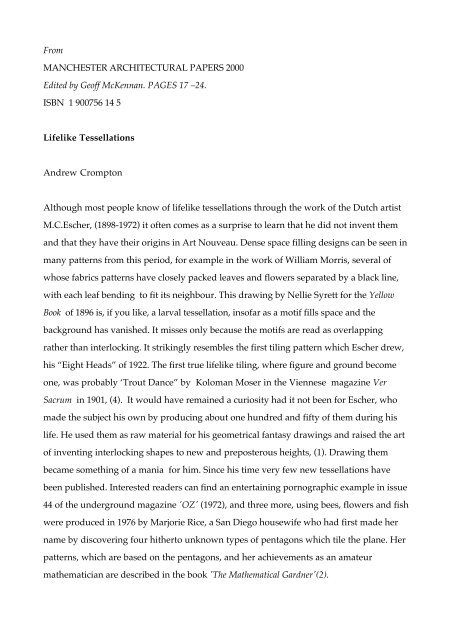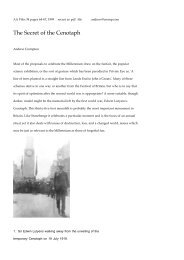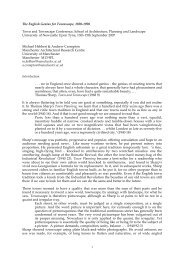Lifelike tessellations. - Andrew Crompton
Lifelike tessellations. - Andrew Crompton
Lifelike tessellations. - Andrew Crompton
- No tags were found...
You also want an ePaper? Increase the reach of your titles
YUMPU automatically turns print PDFs into web optimized ePapers that Google loves.
From<br />
MANCHESTER ARCHITECTURAL PAPERS 2000<br />
Edited by Geoff McKennan. PAGES 17 –24.<br />
ISBN 1 900756 14 5<br />
<strong>Lifelike</strong> Tessellations<br />
<strong>Andrew</strong> <strong>Crompton</strong><br />
Although most people know of lifelike <strong>tessellations</strong> through the work of the Dutch artist<br />
M.C.Escher, (1898-1972) it often comes as a surprise to learn that he did not invent them<br />
and that they have their origins in Art Nouveau. Dense space filling designs can be seen in<br />
many patterns from this period, for example in the work of William Morris, several of<br />
whose fabrics patterns have closely packed leaves and flowers separated by a black line,<br />
with each leaf bending to fit its neighbour. This drawing by Nellie Syrett for the Yellow<br />
Book of 1896 is, if you like, a larval tessellation, insofar as a motif fills space and the<br />
background has vanished. It misses only because the motifs are read as overlapping<br />
rather than interlocking. It strikingly resembles the first tiling pattern which Escher drew,<br />
his “Eight Heads” of 1922. The first true lifelike tiling, where figure and ground become<br />
one, was probably ‘Trout Dance” by Koloman Moser in the Viennese magazine Ver<br />
Sacrum in 1901, (4). It would have remained a curiosity had it not been for Escher, who<br />
made the subject his own by producing about one hundred and fifty of them during his<br />
life. He used them as raw material for his geometrical fantasy drawings and raised the art<br />
of inventing interlocking shapes to new and preposterous heights, (1). Drawing them<br />
became something of a mania for him. Since his time very few new <strong>tessellations</strong> have<br />
been published. Interested readers can find an entertaining pornographic example in issue<br />
44 of the underground magazine 'OZ' (1972), and three more, using bees, flowers and fish<br />
were produced in 1976 by Marjorie Rice, a San Diego housewife who had first made her<br />
name by discovering four hitherto unknown types of pentagons which tile the plane. Her<br />
patterns, which are based on the pentagons, and her achievements as an amateur<br />
mathematician are described in the book 'The Mathematical Gardner'(2).
figure 1<br />
Flächenkunst. by Kolo Moser 1901<br />
figure 2<br />
The Yellow Book 1896, Frontispiece by Nellie Syrett
Aside from these there have been several books, mostly aimed at school children, giving<br />
instructions for drawing <strong>tessellations</strong> which approach the subject from a mathematical<br />
point of view, but the results are disappointing and are not to be compared with any of<br />
Escher's work. A search for people drawing <strong>tessellations</strong>, begun in 1990, in libraries, by<br />
advertising, and eventually on the internet has so far discovered 30 people in the world<br />
drawing them to a reasonable standard, examples of their work have been collected at ,<br />
www.cromp.com/tess/home.html. Of these people Japanese artist Makato Nokamura’s<br />
work is especially good.<br />
It is trivially easy to construct shapes which will tile the plane but to draw one which looks<br />
like something can be difficult. To do it successfully involves a little geometry, a little art,<br />
and a lot of willpower. The results are often more like miniature works of engineering<br />
than drawings. The process is well suited to an architect since it resembles drawing a plan<br />
in that one has to continuously refine, adjust and make compromises between competing<br />
elements. A good tessellation has a slightly lunatic air, and ought to seem vaguely<br />
impossible, the important thing is that the perimeter of each tile has a double value, if this<br />
is not done properly the shapes will simply seem to overlap each other.<br />
Figure 3<br />
Badger line<br />
Figure 4<br />
Badger Tiling
Tessellations are minimal drawings, for example the patterns of badgers shown here is<br />
formed by repeating this motif. It is difficult to imagine a badger drawn with a simpler<br />
line. This economy of expression is achieved making every point along its length have<br />
two meanings, one for each side of the line. This visual irony is the quality which brings<br />
the drawing to life.<br />
One approach to drawing lifelike tilings is to use an algorithm to create tiles at random in<br />
the hope that one will be produced which looks like something. This crude method works<br />
surprisingly well, and is good for creating tilings which interlock shapes in unusual ways.<br />
The more usual method however, is to draw the thing to be tessellated then try to fit it to<br />
copies of itself using tracing paper. The process is made easier if it is realised that certain<br />
combinations are always impossible, for example, although four or six tiles may be fitted<br />
around a point, five never can. Although ordinary graphics software such as Freehand is<br />
useful for drawing the final pattern software for inventing the thing in the first place is<br />
generally an impediment. Some simple programmes for generating patterns<br />
automatically whilst working on a motif do exist but they obscure rather than illuminate<br />
the essential problem, which is working up and improving a simple line. This is an activity,<br />
like life drawing, in which using paper and a pencil is an advantage.<br />
Although some of the earliest work on the mathematics of tilings was done by Kepler the<br />
subject was not taken completely seriously by mathematicians until fairly recently.It has<br />
now however, become mathematically respectable. Geometry, especially the study of<br />
fractals and tilings, has seen a revival in the last twenty years or so in no small part due to<br />
computer graphics which has enabled the study of patterns which would have been either<br />
impossible or unbearably tedious to draw by hand. The standard work on the<br />
mathematics of tilings is ‘Tilings and Patterns” by Grunbaüm and Shepard (3), which<br />
draws on an unexpectedly rich field of ideas, including group theory, topology, and logic.<br />
The discovery of Penrose tilings which exist in a nether world between symmetry and<br />
asymmetry are one of the most exciting developments in the field.
Figure 5<br />
Isohedral pattern of birds<br />
Figure 6<br />
Anisohedral pattern of birds<br />
Tilings are conveniently divided into two types, isohedral and anisohedral. Sometimes a<br />
shape can form patterns of both types, the birds shown here are isohedral when they are<br />
tiled in rows and anisohedral where they grow from a point. In an isohedral pattern every<br />
tile is identically situated, in anisohedral patterns a tile can occur in different ways in the<br />
pattern, in this case either near or far from the centre. Isohedral patterns are,<br />
mathematically speaking, well behaved and well understood, the remaining, anisohedral<br />
tilings which include such oddities as Penrose tilings, and Voderberg spirals (3), are not so<br />
easy to classify and enumerate. All Escher’s patterns, in fact nearly all patterns in<br />
everyday use, are isohedral or have an isohedral repeating unit, not least because they<br />
can be printed from a roller. Anisohedral patterns have hardly been discovered by<br />
designers, even though their controlled irregularity offers some challenging<br />
opportunities.
<strong>Lifelike</strong> <strong>tessellations</strong> are based on patterns of polygons with their sides replaced by motifs,<br />
the pattern of badgers for example was formed by substituting the sides of an<br />
parallelogram. This is the simplest algorithm but there are many others, is it possible to<br />
list all them all? If we restrict ourselves to isohedral patterns the answer to this question is<br />
yes, in 1977 Grunbaum and Shepard’s nineteen page proof showed that there are only 81<br />
isohedral types tilings of the plane to which they named IH1 to IH81. Each of the isohedral<br />
types may be used as an algorithm for drawing <strong>tessellations</strong>. The badgers shown here<br />
belongs to type IH41.The total of 81 types included patterns which contain straight edges,<br />
for example one of the types is a pattern of squares in its own right, and if those are set<br />
aside there remain forty nine ways of drawing tilings where you are free to alter the<br />
entire perimeter of each tile. An abstract example is each of the forty nine types is shown<br />
here.<br />
Figure 7<br />
Key to forty nine ways of drawing lifelike <strong>tessellations</strong>
Figure 8<br />
Forty nine isohedral types of tiling the plan<br />
There is a strange charm to this diagram, all the tilings are as fundamentally different as<br />
are the elements in the periodic table, it shows the fundamental limits on the ways that a<br />
shape may be combined with itself to cover the plane. None could be smoothly morphed<br />
into another without going through some intermediate form which is simpler than either<br />
of them. Those which have at one time or another been used for lifelike tilings are shown<br />
shaded so the number of white cells indicates that many ways of combining shapes in<br />
lifelike <strong>tessellations</strong> are as yet unexplored. It is common enough for architects and<br />
designers to divide up space in a regular way, this diagram shows that there are many<br />
ways of doing this which are unsuspected and unexplored.
Bibliography<br />
http://dspace.dial.pipex.com/crompton/Home.shtml<br />
(1) M.C.Escher’s Universe of Minds Play<br />
Edited by Fuji Television Gallery, published by the Odakyu Department Store 1983.<br />
(2) The Mathematical Gardner.<br />
Edited by David A Klarner, Prindle, Weber and Schmidt, Boston 1981.<br />
(3) Tilings and Patterns.<br />
Grunbaüm and Shepard, W.H.Freeman, 1987<br />
(4) M.C.Escher, Art & Science.<br />
North Holland 1986, Edited by Coxeter, Emmer, Penrose, Teuber.<br />
Proceeding of the International Conference on Escher, Rome 1985.<br />
A collection articles by scientists and art historians.




